2011 KIA Soul oil
[x] Cancel search: oilPage 333 of 356
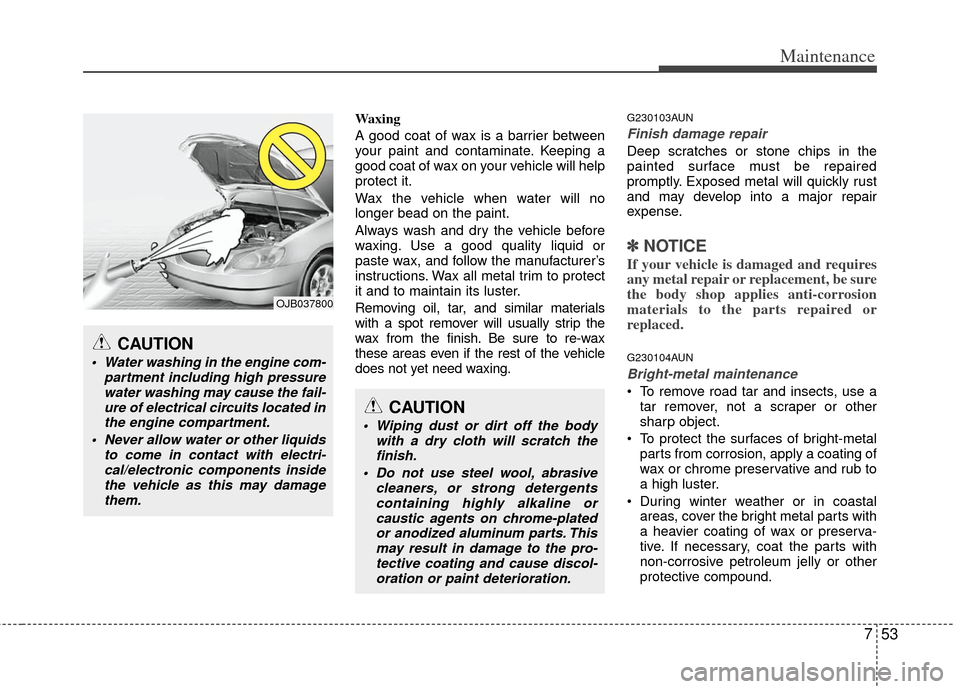
753
Maintenance
Waxing
A good coat of wax is a barrier between
your paint and contaminate. Keeping a
good coat of wax on your vehicle will help
protect it.
Wax the vehicle when water will no
longer bead on the paint.
Always wash and dry the vehicle before
waxing. Use a good quality liquid or
paste wax, and follow the manufacturer’s
instructions. Wax all metal trim to protect
it and to maintain its luster.
Removing oil, tar, and similar materials
with a spot remover will usually strip the
wax from the finish. Be sure to re-wax
these areas even if the rest of the vehicle
does not yet need waxing.G230103AUN
Finish damage repair
Deep scratches or stone chips in the
painted surface must be repaired
promptly. Exposed metal will quickly rust
and may develop into a major repair
expense.
✽ ✽NOTICE
If your vehicle is damaged and requires
any metal repair or replacement, be sure
the body shop applies anti-corrosion
materials to the parts repaired or
replaced.
G230104AUN
Bright-metal maintenance
To remove road tar and insects, use a
tar remover, not a scraper or other
sharp object.
To protect the surfaces of bright-metal parts from corrosion, apply a coating of
wax or chrome preservative and rub to
a high luster.
During winter weather or in coastal areas, cover the bright metal parts with
a heavier coating of wax or preserva-
tive. If necessary, coat the parts with
non-corrosive petroleum jelly or other
protective compound.
CAUTION
Water washing in the engine com- partment including high pressurewater washing may cause the fail-ure of electrical circuits located inthe engine compartment.
Never allow water or other liquids to come in contact with electri-cal/electronic components insidethe vehicle as this may damagethem.
CAUTION
Wiping dust or dirt off the body with a dry cloth will scratch thefinish.
Do not use steel wool, abrasive cleaners, or strong detergentscontaining highly alkaline or caustic agents on chrome-platedor anodized aluminum parts. Thismay result in damage to the pro-tective coating and cause discol-oration or paint deterioration.
OJB037800
Page 337 of 356

757
Maintenance
Interior care
G230201AHM
Interior general precautions
Prevent caustic solutions such as per-
fume and cosmetic oil from contacting
the dashboard because they may cause
damage or discoloration. If they do con-
tact the dashboard, wipe them off imme-
diately. See the instructions for the prop-
er way to clean vinyl.
G230202AUN
Cleaning the upholstery and interiortrim
Vinyl
Remove dust and loose dirt from vinyl
with a whisk broom or vacuum cleaner.
Clean vinyl surfaces with a vinyl cleaner.
Fabric
Remove dust and loose dirt from fabric
with a whisk broom or vacuum cleaner.
Clean with a mild soap solution recom-
mended for upholstery or carpets.
Remove fresh spots immediately with a
fabric spot cleaner. If fresh spots do not
receive immediate attention, the fabric
can be stained and its color can be
affected. Also, its fire-resistant properties
can be reduced if the material is not
properly maintained.
G230203AUN
Cleaning the lap/shoulder belt web-bing
Clean the belt webbing with any mild
soap solution recommended for cleaning
upholstery or carpet. Follow the instruc-
tions provided with the soap. Do not
bleach or re-dye the webbing because
this may weaken it.
G230204AHM
Cleaning the interior window glass
If the interior glass surfaces of the vehi-
cle become fogged (that is, covered with
an oily, greasy or waxy film), they should
be cleaned with a glass cleaner. Follow
the directions on the glass cleaner con-
tainer.CAUTION
Never allow water or other liquids to come in contact with electrical/electronic components inside thevehicle as this may damage them.
CAUTION
When cleaning leather products(steering wheel, seats etc.), use neutral detergents or low alcoholcontent solutions. If you use highalcohol content solutions oracid/alkaline detergents, the colorof the leather may fade or the sur-face may get stripped off.
CAUTION
Using anything but recommendedcleaners and procedures may affectthe fabric’s appearance and fire-resistant properties.
CAUTION
Do not scrape or scratch the insideof the rear window. This may resultin damage of the rear window defroster grid.
Page 344 of 356
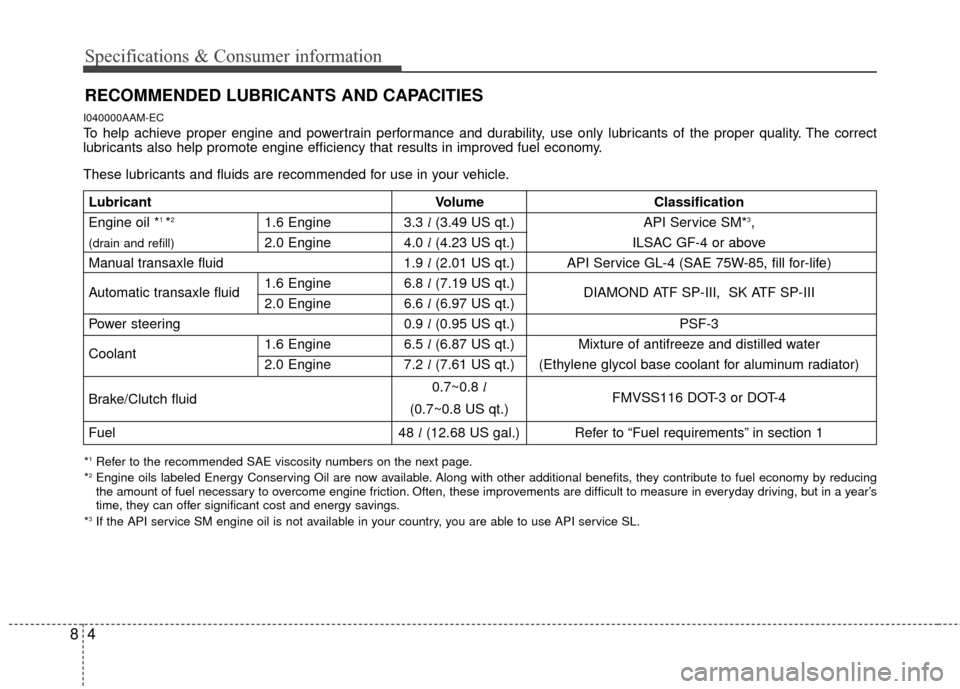
Specifications & Consumer information
48
RECOMMENDED LUBRICANTS AND CAPACITIES
I040000AAM-EC
To help achieve proper engine and powertrain performance and durability, use only lubricants of the proper quality. The correct
lubricants also help promote engine efficiency that results in improved fuel economy.
These lubricants and fluids are recommended for use in your vehicle.
*1Refer to the recommended SAE viscosity numbers on the next page.
*2Engine oils labeled Energy Conserving Oil are now available. Along with other additional benefits, they contribute to fuel econo my by reducing
the amount of fuel necessary to overcome engine friction. Often, these improvements are difficult to measure in everyday driving, but in a year’s
time, they can offer significant cost and energy savings.
*
3If the API service SM engine oil is not available in your country, you are able to use API service SL.
Lubricant Volume Classification
Engine oil *
1 *2 1.6 Engine 3.3 l (3.49 US qt.) API Service SM*3,
(drain and refill)2.0 Engine4.0 l(4.23 US qt.) ILSAC GF-4 or above
Manual transaxle fluid 1.9 l(2.01 US qt.) API Service GL-4 (SAE 75W-85, fill for-life)
Automatic transaxle fluid 1.6 Engine 6.8 l
(7.19 US qt.)
DIAMOND ATF SP-III, SK ATF SP-III
2.0 Engine 6.6 l(6.97 US qt.)
Power steering 0.9 l(0.95 US qt.) PSF-3
1.6 Engine 6.5 l (6.87 US qt.) Mixture of antifreeze and distilled water
Coolant
2.0 Engine7.2 l(7.61 US qt.) (Ethylene glycol base coolant for aluminum radiator)
Brake/Clutch fluid 0.7~0.8
l
FMVSS116 DOT-3 or DOT-4
(0.7~0.8 US qt.)
Fuel 48 l(12.68 US gal.) Refer to “Fuel requirements” in section 1
Page 345 of 356
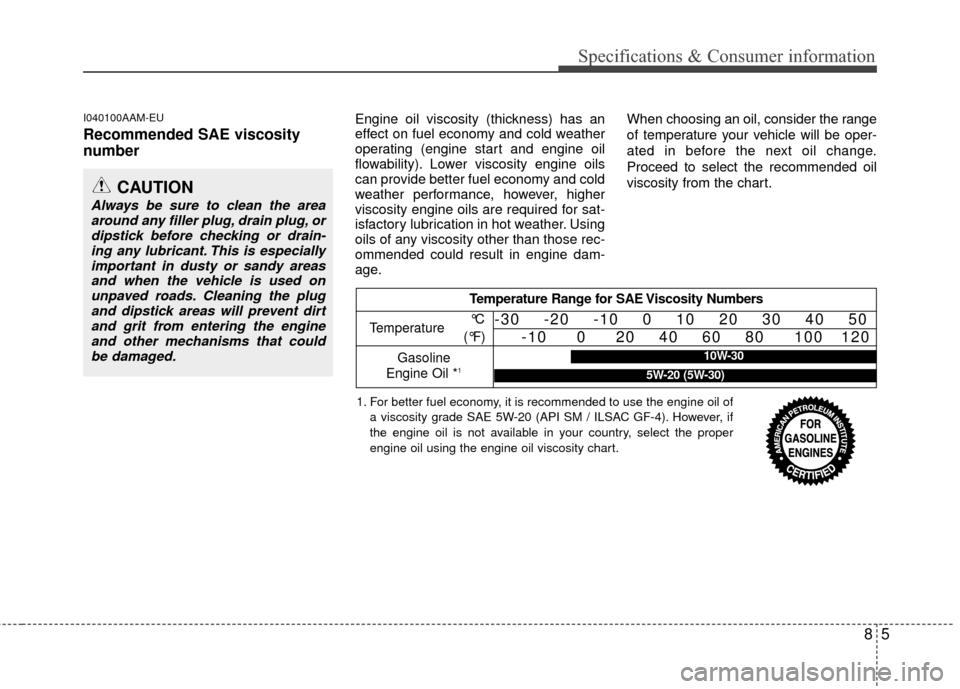
85
Specifications & Consumer information
I040100AAM-EU
Recommended SAE viscosity
number
Engine oil viscosity (thickness) has an
effect on fuel economy and cold weather
operating (engine start and engine oil
flowability). Lower viscosity engine oils
can provide better fuel economy and cold
weather performance, however, higher
viscosity engine oils are required for sat-
isfactory lubrication in hot weather. Using
oils of any viscosity other than those rec-
ommended could result in engine dam-
age.When choosing an oil, consider the range
of temperature your vehicle will be oper-
ated in before the next oil change.
Proceed to select the recommended oil
viscosity from the chart.
CAUTION
Always be sure to clean the area
around any filler plug, drain plug, ordipstick before checking or drain-ing any lubricant. This is especiallyimportant in dusty or sandy areasand when the vehicle is used onunpaved roads. Cleaning the plugand dipstick areas will prevent dirt and grit from entering the engineand other mechanisms that couldbe damaged.
Temperature Range for SAE Viscosity Numbers
Temperature
Gasoline
Engine Oil *
1
°C
(°F)-30 -20 -10 0 10 20 30 40 50 -10 0 20 40 60 80 100 120
1. For better fuel economy, it is recommended to use the engine oil of
a viscosity grade SAE 5W-20 (API SM / ILSAC GF-4). However, if
the engine oil is not available in your country, select the proper
engine oil using the engine oil viscosity chart.
10W-30
5W-20 (5W-30)
Page 351 of 356
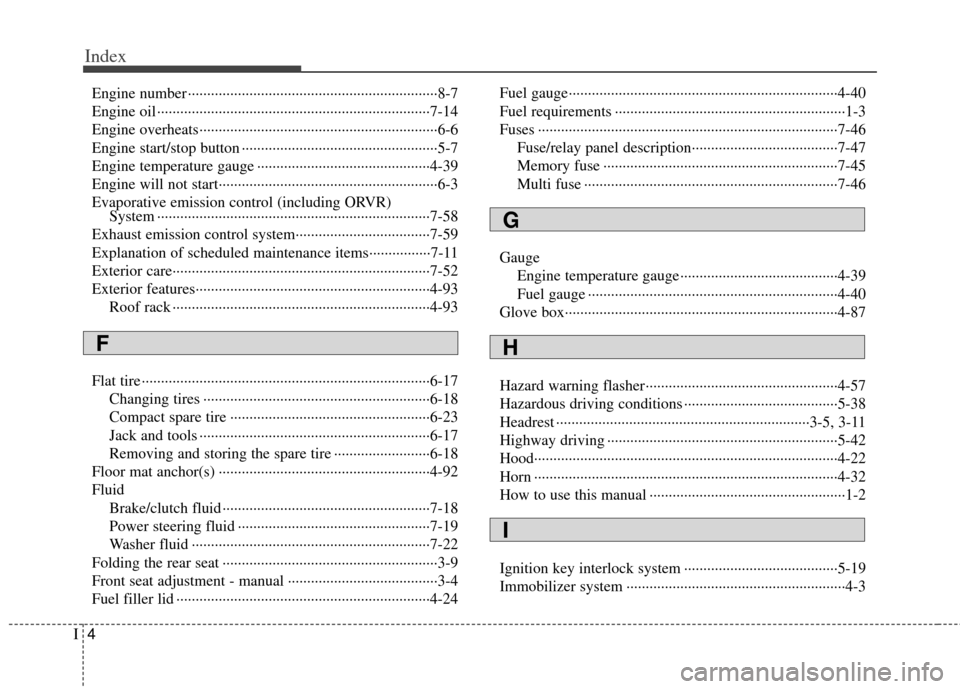
Index
4I
Engine number ··················\
··················\
··················\
···········8-7
Engine oil ··················\
··················\
··················\
·················7-14\
Engine overheats··················\
··················\
··················\
········6-6
Engine start/stop button ··················\
··················\
···············5-7
Engine temperature gauge ··················\
··················\
·········4-39
Engine will not start··················\
··················\
··················\
···6-3
Evaporative emission control (including ORVR) System ··················\
··················\
··················\
·················7-58\
Exhaust emission control system··················\
·················7-59\
Explanation of scheduled maintenance items················7-11
Exterior care··················\
··················\
··················\
·············7-52
Exterior features··················\
··················\
··················\
·······4-93 Roof rack ··················\
··················\
··················\
·············4-93
Flat tire ··················\
··················\
··················\
··················\
···6-17 Changing tires ··················\
··················\
··················\
·····6-18
Compact spare tire ··················\
··················\
················6-23
Jack and tools ··················\
··················\
··················\
······6-17
Removing and storing the spare tire ··················\
·······6-18
Floor mat anchor(s) ··················\
··················\
··················\
·4-92
Fluid Brake/clutch fluid ··················\
··················\
··················\
7-18
Power steering fluid ··················\
··················\
··············7-19
Washer fluid ··················\
··················\
··················\
········7-22
Folding the rear seat ··················\
··················\
··················\
··3-9
Front seat adjustment - manual ··················\
··················\
···3-4
Fuel filler lid ··················\
··················\
··················\
············4-24 Fuel gauge··················\
··················\
··················\
················4-40
Fuel requirements ··················\
··················\
··················\
······1-3
Fuses ··················\
··················\
··················\
··················\
······7-46
Fuse/relay panel description··················\
··················\
··7-47
Memory fuse ··················\
··················\
··················\
·······7-45
Multi fuse ··················\
··················\
··················\
············7-46
Gauge Engine temperature gauge··················\
··················\
·····4-39
Fuel gauge ··················\
··················\
··················\
···········4-40
Glove box··················\
··················\
··················\
·················4-87\
Hazard warning flasher··················\
··················\
··············4-57
Hazardous driving conditions ··················\
··················\
····5-38
Headrest ··················\
··················\
··················\
············3-5, 3-11
Highway driving ··················\
··················\
··················\
······5-42
Hood··················\
··················\
··················\
··················\
·······4-22
Horn ··················\
··················\
··················\
··················\
·······4-32
How to use this manual ··················\
··················\
···············1-2
Ignition key interlock system ··················\
··················\
····5-19
Immobilizer system ··················\
··················\
··················\
···4-3
F
G
H
I
Page 353 of 356
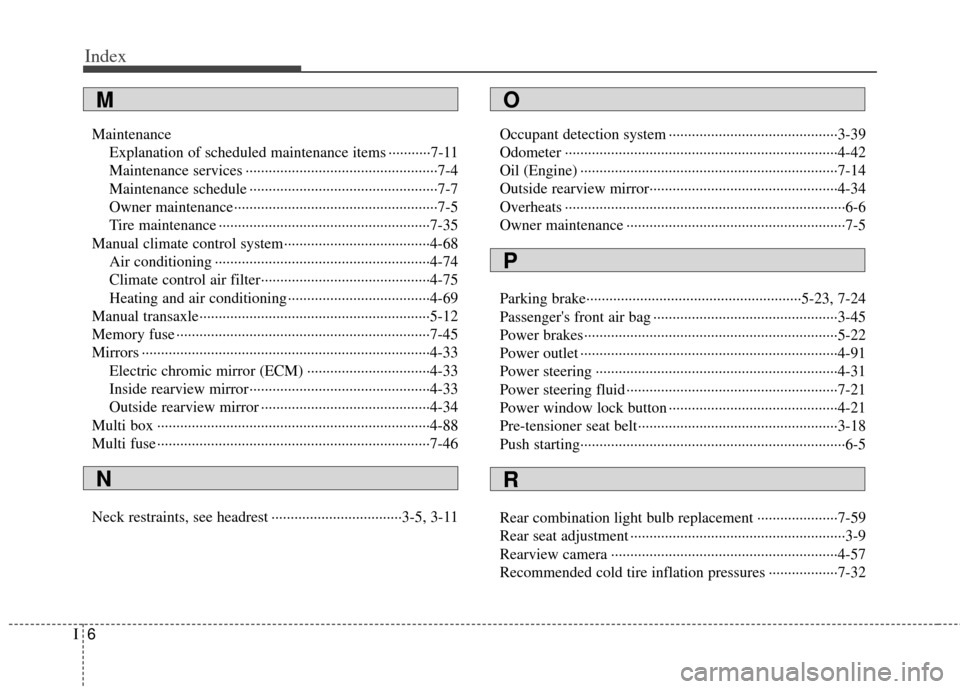
Index
6I
MaintenanceExplanation of scheduled maintenance items ···········7-11
Maintenance services ··················\
··················\
··············7-4
Maintenance schedule ··················\
··················\
·············7-7
Owner maintenance··················\
··················\
·················7-5
Tire maintenance ··················\
··················\
··················\
·7-35
Manual climate control system··················\
··················\
··4-68 Air conditioning ··················\
··················\
··················\
··4-74
Climate control air filter··················\
··················\
········4-75
Heating and air conditioning··················\
··················\
·4-69
Manual transaxle··················\
··················\
··················\
······5-12
Memory fuse ··················\
··················\
··················\
············7-45
Mirrors ··················\
··················\
··················\
··················\
···4-33 Electric chromic mirror (ECM) ··················\
··············4-33
Inside rearview mirror··················\
··················\
···········4-33
Outside rearview mirror ··················\
··················\
········4-34
Multi box ··················\
··················\
··················\
·················4-88\
Multi fuse ··················\
··················\
··················\
·················7-46\
Neck restraints, see headrest ··················\
················3-5, 3-1\
1 Occupant detection system ··················\
··················\
········3-39
Odometer ··················\
··················\
··················\
·················4-42\
Oil (Engine) ··················\
··················\
··················\
·············7-14
Outside rearview mirror··················\
··················\
·············4-34
Overheats ··················\
··················\
··················\
··················\
·6-6
Owner maintenance ··················\
··················\
··················\
···7-5
Parking brake··················\
··················\
··················\
··5-23, 7-24
Passenger's front air bag ··················\
··················\
············3-45
Power brakes··················\
··················\
··················\
············5-22
Power outlet ··················\
··················\
··················\
·············4-91
Power steering ··················\
··················\
··················\
·········4-31
Power steering fluid ··················\
··················\
··················\
·7-21
Power window lock button ··················\
··················\
········4-21
Pre-tensioner seat belt··················\
··················\
················3-18
Push starting··················\
··················\
··················\
···············6-5
Rear combination light bulb replacement ··················\
···7-59
Rear seat adjustment ··················\
··················\
··················\
··3-9
Rearview camera ··················\
··················\
··················\
·····4-57
Recommended cold tire inflation pressures ··················\
7-32
O
P
R
M
N